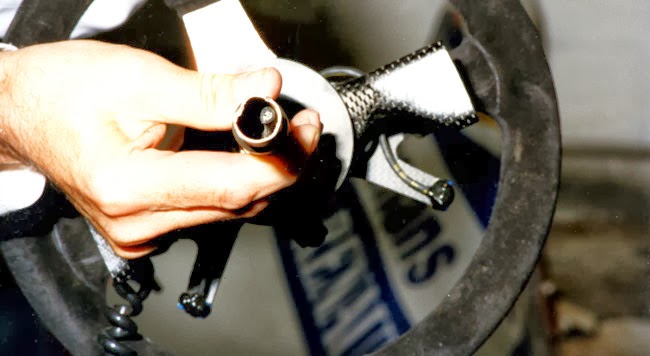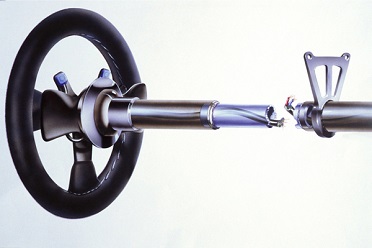killed in a crash on the 7th lap of the 1994 San Marino Grand Prix
when his car went straight at the 190 mile-per-hour left-handed turn 1
known as Tamburello Corner. The car hit an unprotected concrete barrier
at approximately 130 miles-per-hour, and caused the right front wheel
of the car to break off and hit Senna in the helmet. This, along with the
g-forces of the crash, are what innevitably lead to his death. However,
the cause of the crash can be attributed to a failure of the steering
column in his car and previous modifications to it.
Engineering Perpsective
and too far forward in the cockpit that weekend. In order to modify it,
team engineers removed the steering column, cut a section from it, and
welded it back together. When the race began, a crash at the very start
caused the race to be yellow-flagged (slowed down). Racing resumed on lap
number 6, and Ayrton went through that corner for the first time at full
speed. 3.1 miles later (the length of the track), Ayrton entered the
corner for the second time at full-speed on lap 7. At which point, the
weld failed, causing the steering wheel to no longer turn the front wheels
and sending the car into a straight trajectory towards the barrier. Ayrton
managed to downshift twice and slow the car from 192 MPH to 131 MPH, but
unfortunately that was not enough to save his life.
In 1994, Formula 1 cars were permitted to use a power steering system in
order to reduce the effort required to turn the steering wheel, and thus
reduce the torsion on the steering column. However, the system was still
very early in development, and were not foolproof by any means, and much
of the steering effort was still in the hands of the drivers, so the steering
column still had to be withstand a great amount of stresses and strains,
which, when combined with a poor modification attempted on it, can lead
to calamity.
The images shown below show an actual photo of the broken steering column
as well as a visualization of how the two pieces split apart respectively.


Image sources:
The steering column would have been subjected to up to 25Nm of torque, which
given the diameter and wall thickness of the steering column, one could
determine the torsion on the steering column via τ=Tr/J, where T=torque,
r=radius, and J=polar moment of inertia. This torsion, combined with fatigue
of the weld bead due to repeated movements of the wheel in either direction
ultimately lead to failure of the weld, and thus leading to the crash.
Lessons Learned
From this incident, the primary lesson learned is that 'pitlane engineering',
or 'redneck engineering' as some may know it, requires much more planning
and revision when being implemented on such a crucial part of the car. In F1
today, the systems are much more complex and include many, many failsafes to
prevent incidents such as the one which took Senna's life. Any major modifications
nowadays are carried out back at the team's headquarters and involve a great
deal of planning, design, simulation, and prototyping before it is to be implemented
on a race car during a race weekend. Teams nowadays also having specific people
for very specific roles, rather than just one or two engineering staff members
overseeing everything to do with the car prior to race day.
I, personally, can takeaway that modifying a design has risks, and needs careful
attention and planning before it can be implemented. Additionally, even something
that seems "good enough" may be quite the opposite, and that risk taking like that
cannot involve the safety and well-being of a living person.
Footage of the accident can be viewed below, though may be disturbing to some.
An extended version, including footage of the extracation and med-evac transport
can be viewed below as well.
Resources
Source #2:
Source #3:
Source #4:
Source #5:
| |
|
|
|---|